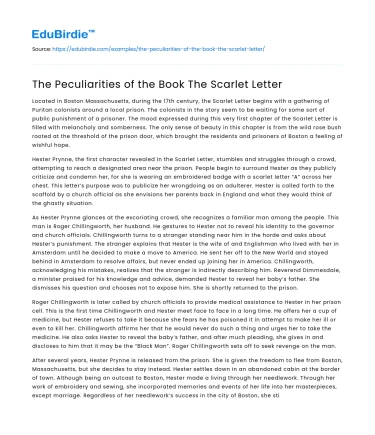Introduction
Nathaniel Hawthorne's "The Scarlet Letter," first published in 1850, stands as a seminal work in American literature, distinguished by its intricate portrayal of sin, guilt, and redemption. Set in a Puritan community in 17th-century Massachusetts, the novel explores profound themes through its complex characters and symbolic narrative. The work's peculiarities lie in its rich use of symbolism, its deep psychological insights, and its exploration of social norms. This essay seeks to analyze these distinctive features, illustrating how they contribute to the novel's enduring relevance and literary acclaim. By examining the interplay between the characters, the societal backdrop, and Hawthorne's narrative techniques, we can better appreciate the novel's unique contributions to literature. Furthermore, addressing counter-arguments regarding its moral implications and narrative style will elucidate the broader implications of Hawthorne's work in the context of its time and beyond.
Symbolism and Allegory in The Scarlet Letter
One of the most striking peculiarities of "The Scarlet Letter" is Hawthorne's masterful use of symbolism and allegory, elements that enrich the narrative and imbue it with deeper meaning. The scarlet letter 'A' itself is a multifaceted symbol, representing not only Hester Prynne's adultery but also the broader themes of sin and societal judgment. As Hester evolves, the 'A' shifts in meaning, from "adultery" to "able," reflecting her resilience and transformation. This dynamic symbolism challenges readers to reconsider the nature of sin and redemption. Supporting this symbolism, the setting of the novel—dark, oppressive, yet capable of beauty—mirrors the inner turmoil of the characters. The forest, for instance, symbolizes freedom and natural law, contrasting with the strictures of Puritan society.
Save your time!
We can take care of your essay
- Proper editing and formatting
- Free revision, title page, and bibliography
- Flexible prices and money-back guarantee
Hawthorne's use of allegory extends beyond individual symbols, encompassing the novel's characters and their experiences. Roger Chillingworth, for instance, embodies vengeance and the destructive nature of obsession, while Reverend Dimmesdale represents the conflict between private guilt and public piety. As literary critic Sacvan Bercovitch observes, "Hawthorne's allegory is not a simple moral tale but a complex exploration of human nature and society" (Bercovitch, 1975). This complexity allows the novel to transcend its historical setting and engage with universal themes. While some critics argue that Hawthorne's heavy reliance on symbolism can obscure the narrative, it is precisely this intricate tapestry of symbols that invites diverse interpretations and rich analytical discourse.
Psychological Depth and Character Development
Another defining feature of "The Scarlet Letter" is its profound psychological depth, which is evident in the intricate development of its characters. Hawthorne delves into the inner lives of Hester, Dimmesdale, and Chillingworth, revealing their motivations and moral struggles. Hester Prynne, as the protagonist, emerges as a complex figure who defies the simplistic categorization of sinner or saint. Her strength and dignity in the face of public condemnation highlight her resilience and capacity for growth, challenging the rigid moral codes of her society. Similarly, Reverend Dimmesdale's internal conflict between his public persona and private guilt offers a compelling study of hypocrisy and self-deception.
Hawthorne employs psychological realism to explore the effects of sin and guilt on the human psyche. As critic Claudia Durst Johnson notes, "Hawthorne's characters are not merely types or symbols; they are fully realized individuals whose psychological struggles resonate with readers" (Johnson, 1995). This psychological complexity enriches the narrative, allowing readers to empathize with the characters and engage with their moral dilemmas. However, some detractors argue that the novel's focus on internal conflicts detracts from the broader social critique. While this perspective has merit, it is the nuanced portrayal of individual struggles that underscores the novel's exploration of societal norms and human nature.
Social Critique and Historical Context
"The Scarlet Letter" also serves as a poignant social critique, reflecting Hawthorne's ambivalence towards the Puritan values of his ancestors. Through the narrative, Hawthorne critiques the rigidity and hypocrisy of Puritan society, exposing its oppressive impact on individual freedom and identity. The public shaming of Hester Prynne illustrates the community's harsh moral judgments and the consequences of nonconformity. This critique is further amplified by the juxtaposition of Hester's strength and the moral weakness of the Puritan leaders, highlighting the disparity between personal integrity and societal expectation.
Hawthorne's historical context informs his critique, as he wrote during a time when America was grappling with questions of morality and identity. The novel's exploration of these themes resonates with contemporary debates over individual rights and social justice. As scholar Michael J. Colacurcio argues, "Hawthorne's depiction of the Puritan world reflects his broader concerns about the moral and cultural direction of 19th-century America" (Colacurcio, 1984). While some critics contend that Hawthorne's portrayal of Puritan society is overly negative, it is this critical lens that allows the novel to engage with timeless questions about the balance between individual freedom and communal norms.
Conclusion
In conclusion, "The Scarlet Letter" remains a quintessential example of American literature, distinguished by its rich symbolism, psychological depth, and incisive social critique. Hawthorne's exploration of sin, guilt, and redemption continues to resonate with readers, offering insights into the complexities of human nature and societal norms. While the novel's heavy reliance on symbolism and allegory may present challenges to some readers, it is precisely these elements that enrich the narrative and invite diverse interpretations. By addressing counter-arguments and considering the historical context, we gain a fuller understanding of the novel's unique contributions to literature and its enduring relevance. Ultimately, "The Scarlet Letter" invites us to reflect on the moral implications of our actions and the ways in which societal judgments shape individual identity.






 Stuck on your essay?
Stuck on your essay?

